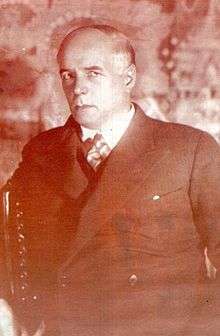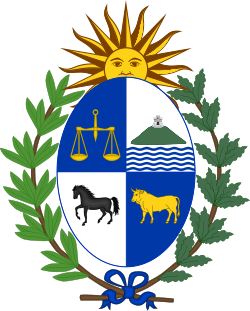Gabriel Terra
Dr. Gabriel Terra Leivas (August 1, 1873 – September 15, 1942) was the President of Uruguay from 1931 to 1938.
Gabriel Terra | |
|---|---|
 Gabriel Terra in 1913. | |
| President of Uruguay | |
| In office 1 March 1931 – 19 June 1938 | |
| Prime Minister | Juan Pedro Fabini Antonio Rubio |
| Vice President | Alfredo Navarro |
| Preceded by | Juan Campisteguy |
| Succeeded by | Alfredo Baldomir |
| Personal details | |
| Born | August 1, 1873 |
| Died | September 15, 1942 (aged 69) |
| Nationality | Uruguayan |
| Political party | Colorado Party |
| Spouse(s) | María Marcelina Ilarraz Miranda |
| Alma mater | Universidad de la República |
| Occupation | Politician, lawyer |
Background
Born in Montevideo to a wealthy family, he graduated from the University of Uruguay in 1895, and subsequently joined the faculty.
He began his career as a member of the Colorado Party under his predecessor as president, José Batlle y Ordóñez in a number of government roles. He served as the President of the Chamber of Deputies of Uruguay from 1923 to 1924.[1] From 1925 he was the minister for Industry and Employment.
His nephew Horacio Terra Arocena served as a Senator.[2] His great-nephew Juan Pablo Terra served as a Deputy and a Senator.
President of Uruguay
After being selected to lead the country by the congress in 1930, he came to power in 1931. On March 1, 1931 he assumed the Presidency of the Republic for the period 1931-1938. From the beginning, he opposed the Constitution of 1918. On March 31, 1933, with the support of the police, (led by his brother-in-law, Alfredo Baldomir) the Army, and the majority sector of the National Party (led by Luis Alberto de Herrera) he brought about a coup d'etat. The Parliament was dissolved, and he disbanded the National Council of Administration, a special body set up in 1919 to provide checks and balances. This was soon followed by the total abolition of the constitution, the censorship of the press, and the merger of state powers with the presidency. He set up a government of conservative, authoritarian and illiberal character, in opposition to Batllismo and to the left. He produced a new constitution in 1934 and he put himself up for election, and was elected under a shroud of suspicion.The period opened by the coup is called the Terra Dictatorship.
Particularly after 1933, Terra was tellingly closer politically to his nominal National Party (Uruguay) opponent Dr. Luis Alberto de Herrera than he was to many of his Colorado Party (Uruguay) colleagues.[3] Terra predominantly ruled harshly and by diktat, but continued most of the socialist reforms begun by his predecessor.
During 1934 and 1935 there were many moments of political tension, with attempts at rebellion that failed, such as the Revolutionary Putsch of 1935. The main confrontation of this event was the Paso Morlan Skirmish, on February 28, 1935, which was quickly suppressed by the police forces. Paso Morlan was followed by the arrest, exile and confinement of 70 political prisoners on the Isla de Flores, including the Socialist Emilio Frugoni, nationalist Gustavo Gallinal, the batllista Luis Batlle Berres, the writer Francisco "Paco" Espinola and veterinary researcher Miguel C. Rubino. They were arrested, imprisoned or lost their public office, those university graduates who did not sign a letter expressing allegiance to Terra's regime. Many had to escape to Argentina to avoid being arrested and interned on the Isla de Flores. Another victim of the Terra Dictatorship was Doctor Julio Caesar Grauert, who was shot by police upon returning from a political event on October 26, 1933, and was left without medical attention and died of gangrene.
Terra's interior minister was Alberto Demicheli, who much later was himself to become President of Uruguay as an interim measure in 1976. Demichelli's wife, Sofía Álvarez Vignoli de Demicheli, was noted for her diplomatic activity during Terra's Presidency.
Terra's Vice President was Alfredo Navarro, who served from 1934 to 1938.
Terra was noted for bringing into his government former opposition figures such as Martín Echegoyen, who himself later became President of Uruguay and, like Alberto Demicheli, subsequently participated prominently in the civilian-military rule which took office under Juan María Bordaberry after 1973.
He broke off relations with the USSR and the Spanish Republic, while he met Roosevelt and Britain regarding his debts to them. Later he made a close friendship with Hitler and Mussolini who lent him a loan with no return to construct the Rincón del Bonete Lake Hydro Dam and Power Plant.
Following his presidency, Terra became the president of Banco de la República Oriental del Uruguay from 1938 to 1939.[4]
Sources
References
- PRESIDENCIA DE LA ASAMBLEA GENERAL Y DEL SENADO PRESIDENCIA DE LA CAMARA DE REPRESENTANTES (October 29, 2013). "Parlamentarios Uruguayos 1830-2005" (PDF). www.parlamento.gub.uy. Archived from the original (PDF) on October 29, 2013.
- 'Horacio Terra Arocena' Wikipedia (in Spanish), es:Horacio Terra Arocena,
- es:Luis Alberto de Herrera#Participación en el golpe de Estado de Gabriel Terra
- Diego Aboal and Gabriel Oddone. "Reglas versus Discrecionalidad: La Política Monetaria en Uruguay entre 1920 y 2000" (PDF). Banco Central del Uruguay.
External links
| Wikimedia Commons has media related to Gabriel Terra. |
- Escuadrilla de Alta Acrobacia de Italia en Uruguay on YouTube
- Avión Breda "Leonardo Da Vinci" Aviación Civil Uruguaya. on YouTube
| Political offices | ||
|---|---|---|
| Preceded by Juan Campisteguy |
President of Uruguay 1931–1938 |
Succeeded by Alfredo Baldomir |
